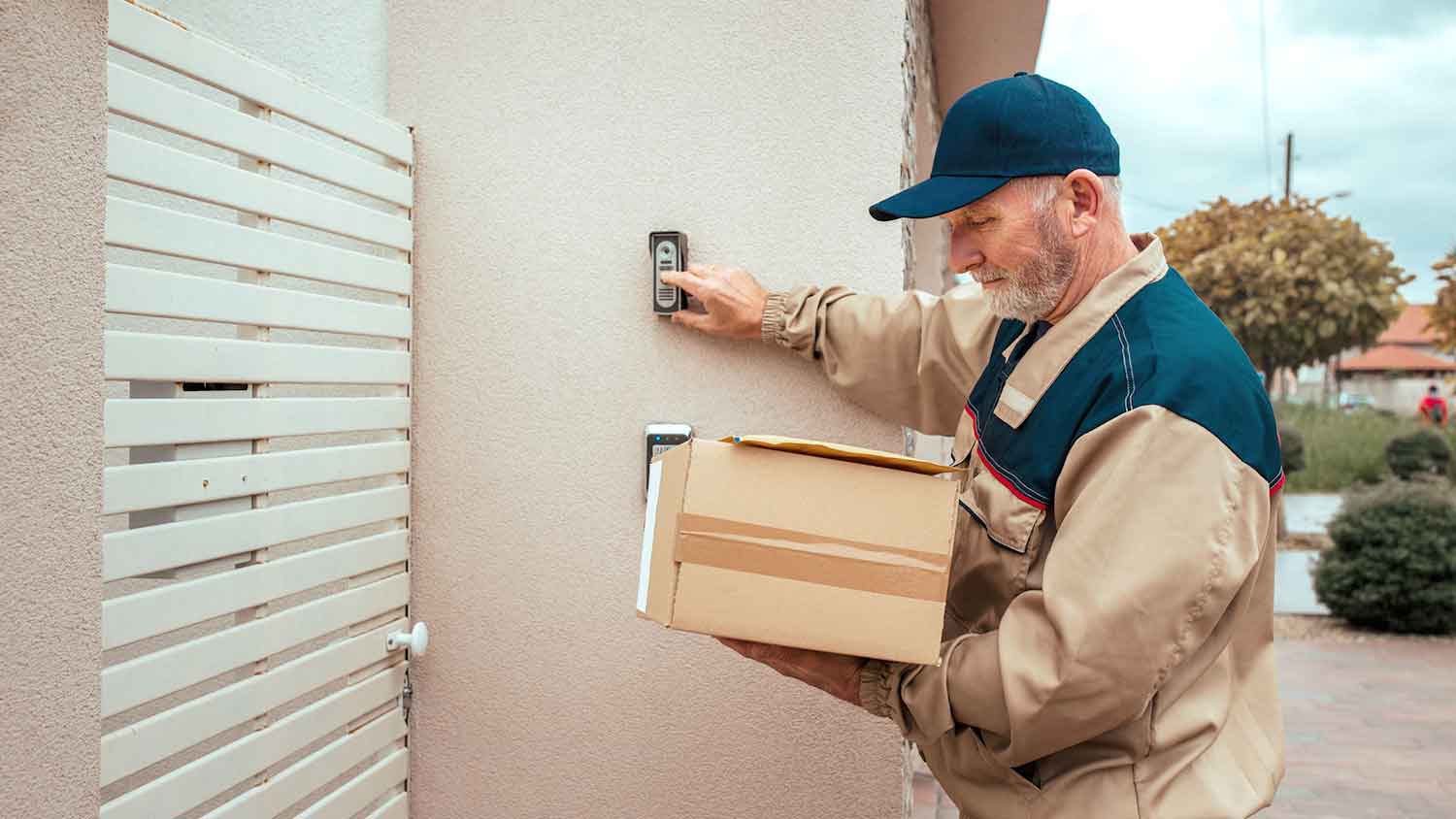Why Is My Wired Doorbell Not Working?
Ding-dong! The wiring is dead


If your doorbell isn't working, the problem can be attributed to its three parts:the button, chime, and transformer.
A wired doorbell can stop working because of wiring issues or a broken button.
Troubleshoot a non-working doorbell by checking the circuit breaker.
If you’ve been waiting for the chime at the front door but find a "Sorry we missed you" notification you may wonder why your wired doorbell is not working. The culprits may range from a broken button to wiring issues. Here are the most common causes and how to handle them so you don’t miss a package again.
1. Tripped Circuit
If your doorbell isn't sounding and other electronic devices in your home aren't working, it could be caused by a tripped circuit. Even if other lights and electronics are working, your wired doorbell could have its own circuit.
How to Fix It
Take a look at your breaker box to see if one of the circuits has tripped. It may be fully switched in the off position or stuck halfway between on and off. To reset it, gently push the lever back toward on. Test your doorbell to see if it works.
2. Loose Wiring

True to its name, a wired doorbell connects the facade and button to other internal elements that make it ring. If the connection between the wiring and a component becomes loose, the doorbell will stop working.
How to Fix It
To be on the safe side, turn off the power in your home or flip the circuit that is connected to your doorbell. Remove the doorbell button fixture from the outside wall and check to make sure the two wires in the back are securely connected. Usually, the wires are held in place by two screws. If those screws are loose, gently tighten them to restore the connection.
If the wires are in place, check the chime, which is located inside your home. Finally, inspect the transformer to make sure the wires there are securely connected.
If you're not comfortable working on wiring projects, consider hiring an electrician or doorbell installation professional to take a look.
3. Silent Chime
If the circuit hasn't been tripped and the wiring connecting your doorbell components is secure, the issue may be with the doorbell's chime. The chime is the small box that is located inside of your home, usually near the door.
How to Fix It
You're going to want to hire a pro electrician to handle this one, as it requires getting into the guts of the chime and testing it out with a multimeter. The electrician will connect the chime to a multimeter and press the doorbell button (or ask you). If the multimeter shows a current flowing to the chime, but there's no sound, it's time to replace the chime with a new one.
4. Broken Button

In some cases the wired doorbell system is fine, but a broken button is what keeps it from ringing. If the doorbell's button is faulty—for example, if it's stuck or pushed in—the bell won't make a sound when it's pushed.
How to Fix It
Remember those two wires on the back of the doorbell button? You’ll need to test these to determine whether the button is the cause of a broken doorbell. Loosen the screws holding the wires in place. Then, carefully touch the two wires together. If the doorbell dings, you know the wiring is fine and you need to address the actual button.
You can purchase a new doorbell button and install it to replace the faulty one. When buying a new button, make sure it's the same voltage as your doorbell system, which should be listed on the chime or the transformer. If you don't see the voltage listed, an electrician can test it using a multimeter.
5. Troubled Transformer
If the button, chime, and wiring are all fine, the next place to look is your doorbell's transformer. Wired doorbells don't require a lot of voltage to operate—usually just 10 or 20 volts, compared to the standard 120 volts used in the electrical systems in U.S. homes. The transformer ensures that the doorbell doesn't get more voltage than it can handle. But, if there's a problem with it, the bell will stop working.
How to Fix It
Bring in an electrician to test and possibly replace your doorbell's transformer. They'll use a multimeter to measure the transformer's voltage. If they get a reading of zero, or close to it, they'll recommend replacement.
When to Call a Pro
While you may be able to get your wired doorbell up and ringing again with a few simple steps, some problems require a professional's help. If you've ruled out a tripped circuit, loose wires, or broken button, and suspect that the chime or transformer may be to blame, it's time to bring in the pros to explore the problem and test the voltage. In the case of a transformer, you'll need a licensed electrician to replace it and ensure it complies with local codes and regulations.
Frequently Asked Questions
While some doorbells go silent, others will ring constantly or randomly when they are on the fritz. A doorbell can ring continuously for a few reasons. The button may be stuck in the "on" position, causing the bell to sound repeatedly. Alternatively, one of the wires could have come loose and is touching a metal surface, causing the bell to short circuit and keep making noise.
The doorbell installation cost depends on which and how many parts you need to replace. A new transformer is the least expensive replacement and falls between $20 and $35, plus the cost of hiring an electrician to install it, which can be between $150 and $250. Replacing your entire doorbell system can cost $250 to $400.



.jpg?impolicy=leadImage)

- Appliance Repair Companies
- Washing Machine Repair
- Dryer Repair
- Refrigerator Repair
- Dishwasher Repair
- Oven Repair
- Wood & Pellet Stove Repair
- Freezer Repair Services
- Wood Stove Services
- Gas Stove Repair
- Emergency Appliance Repair Companies
- Ice Maker Repair
- Gas Appliance Repair
- GE Appliance Repair
- GE Refrigerator Repair
- GE Dryer Repair
- GE Dishwasher Repair
- GE Washing Machine Repair
- Samsung Appliance Repair
- Samsung Refrigerator Repair
- Samsung Dryer Repair
- Samsung Washer Repair
- Samsung Dishwasher Repair
- Samsung Oven Repair
- Whirlpool Repair
- Whirlpool Refrigerator Repair
- Whirlpool Washer Repair
- Whirlpool Dryer Repair
- Whirlpool Oven Repair
- Maytag Appliance Repair
- Maytag Refrigerator Repair
- Maytag Washer Repair
- Maytag Dryer Repair
- Maytag Dishwasher Repair
- Kitchenaid Appliance Repair
- Kitchenaid Oven Repair
- Kitchenaid Refrigerator Repair
- Kenmore Appliance Repair
- Kenmore Dishwasher Repair
- Kenmore Washer Repair
- Kenmore Dryer Repair
- LG Refrigerator Repair
- Bosch Appliance Repair
- Kenmore Refrigerator Repair
- LG Appliance Repair Services
- GE Microwave Repair
- Electrolux Appliance Repair
- Electrolux Washer Repair
- Kitchenaid Dishwasher Repair Services
- Wood Stove Inspection
- Dishwasher Installation
- Trash Compactor Repair









